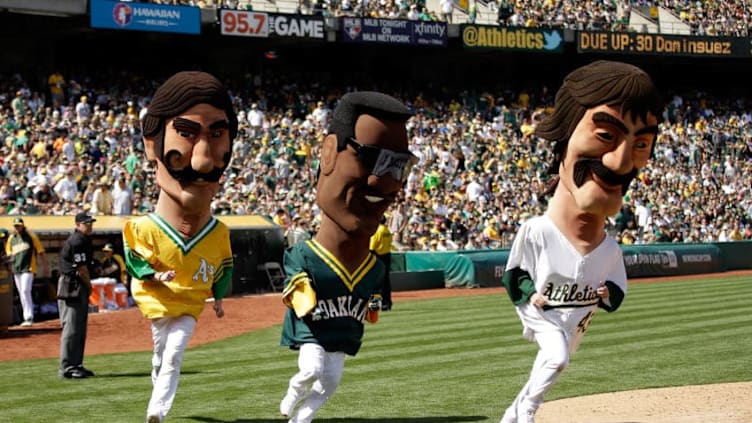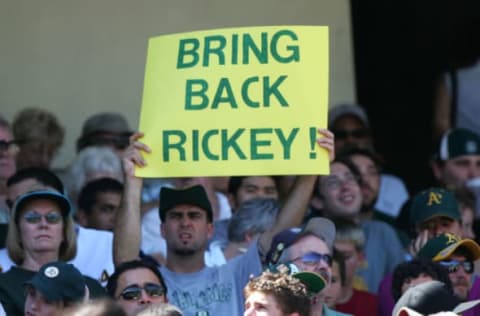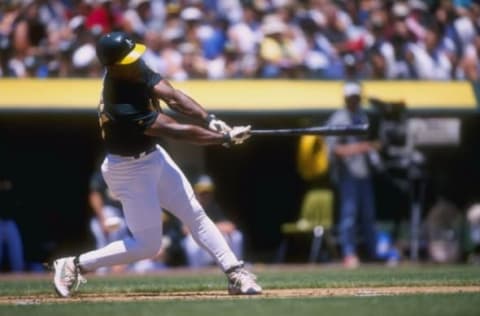Oakland Athletics Mount Rushmore


The Oakland Athletics have gone through years of excellence, and years of mediocrity. Yet through it all, there have been some great players to put on that scripted A.
The Oakland Athletics have been baseball’s vagabonds over the years. One of the charter members of the American League, they spent their first 54 years in Philadelphia, led nearly the entire time by the legendary Connie Mack. They eventually moved to Kansas City for 13 disastrous seasons before eventually heading to Oakland in 1968.
During that time, the Athletics had some moments of brilliance. They were one of the first dynasties in the American League, making the World Series four times from 1910 through 1914. After 14 years without a postseason appearance, the A’s won three championships in a row. Then, it took until their dynasty in the 1970s before they returned to glory.
Over their history, the Athletics had some incredible players come through their clubhouse. Even when they were essentially the Yankees farm team in the late 1950s, there were some good players in Kansas City. They just were not ready for the prime time. As soon as they were, they would be a part of the second New York dynasty.
Which of those players were the best in the history of the Oakland Athletics franchise history? Let us take a look at their Mount Rushmore of top players.
Lefty Grove (1925-1933)
Lefty Grove did not make his major league debut until he was 25 years old. That was because his minor league team, the Baltimore Orioles, refused to part ways with a pitcher who was a once in a generation talent.
When they finally sold him to the Philadelphia Athletics for the princely sum of $100,000, he struggled initially. While he led the American League in strikeouts, Grove had issues with bouts of wildness. However, he quickly adjusted, leading the league in ERA and strikeouts in his second year.
By the time he was traded from the Athletics, Grove had established himself as one of the best pitchers in the game. He was the 1931 AL MVP, winning the second of his Triple Crowns. Grove led the league in ERA five times, and was the strikeout leader in each of his first seven seasons. While he did not have as many strikeouts later in his career, Grove was still a brilliant pitcher into his late 30s.
Although Grove spent just nine years with the Athletics, he had quite the impressive run. Overall, he posted a 195-79 record, with a 2.88 ERA and a 1.250 WHiP. In his 2450.1 innings in Philadelphia, he struck out 1523 batters while issuing 740 walks. Grove even added 50 saves during that time.
Had he reached the majors earlier, Lefty Grove may have been considered one of the greatest pitchers of all time. Even with that delayed start, he was one of the best pitchers of his era, and in the history of the Athletics.
Jimmie Foxx (1925-1935)
Originally a catcher, Jimmie Foxx shifted around the diamond before finding a home at first base. Once he became a regular, it did not take long for him to become a star.
A muscular slugger when that type of player was a rarity, it was said that Foxx had muscles on his muscles. It certainly helped him drive the ball, as he had eight consecutive seasons with 30 or more homers with the Athletics, leading the league three times. He won the Triple Crown in 1933, and won two MVP awards while in Philadelphia. Foxx was also a part of the first nine All Star Games, a fitting tribute for a player of his capabilities.
Overall with the Athletics, Foxx proved to be a key piece in their fearsome lineup. He produced a .339/.440/.640 batting line with Philadelphia, belting 302 homers while driving in 1075 runs. Foxx also drew 781 walks while striking out only 644 times, showing an impressive batting eye for such a powerful slugger.
Eventually, Foxx followed his A’s teammate and fellow member on the franchise Mount Rushmore, Lefty Grove, to Boston. He continued to put up his impressive numbers, and appeared to be a threat to challenge Babe Ruth‘s all time home run mark. However, a horrific beaning led to a sudden decline, and Foxx eventually finished his career as a pitcher with the Phillies in 1945.
One of the most powerful players in the history of the game, Jimmie Foxx would have looked at home in the modern era of baseball. Had he stayed healthy, he could have been one of the all time legends in baseball history.

Rickey Henderson (1979-1984, 1989-1993, 1994-1995, 1998)
There may never be another player like Rickey Henderson in baseball history. If not, then the Oakland Athletics found themselves with the greatest leadoff hitter in the history of the game on four separate occasions.
Henderson changed the game almost from the moment he set foot on the diamond. He was a seven time All Star with the Athletics, won the 1990 AL MVP award, and was a three time Silver Slugger. A rare player who could combine excellent power and speed, he was the perfect leadoff hitter. Henderson led the AL in steals eight times while in Oakland, including three seasons with 100 or more stolen bases.
Overall during his separate stints in Oakland, Henderson showed why he was a major star. He produced a .288/.409/.430 batting line, hitting 167 homers and 289 doubles. Of course, Rickey would not have been Rickey without his legendary speed. As a member of the Athletics, he stole 867 bases, a total that would be fourth all time if we only counted his time in Oakland.
He was far more than a great player. Henderson was also a player that became larger than life. He constantly referred to himself in the third person, and did everything he could to hype himself, as he felt that he did not get enough attention for his ability. There were also quite a few hilarious stories about Henderson during his playing days, although the validity of some of these tales is a bit questionable.
Rickey Henderson set out to be the greatest there ever was. He accomplished that feat, as the Oakland Athletics outfielder changed the game.
Eddie Plank (1901-1914)
Another pitcher that did not start his major league career until later, Eddie Plank made up for lost time in a hurry.
More from Call to the Pen
- Philadelphia Phillies, ready for a stretch run, bomb St. Louis Cardinals
- Philadelphia Phillies: The 4 players on the franchise’s Mount Rushmore
- Boston Red Sox fans should be upset over Mookie Betts’ comment
- Analyzing the Boston Red Sox trade for Dave Henderson and Spike Owen
- 2023 MLB postseason likely to have a strange look without Yankees, Red Sox, Cardinals
One of the top pitchers with the Philadelphia Athletics, he was remarkably consistent. He set records for complete games and shutouts by a lefty, marks which will likely never be equaled. Plank finished in the top ten in wins 12 times during his 14 years in Philadelphia, and was in the top ten in strikeouts 11 times. He threw over 200 innings in each of his first 13 seasons, and surpassed the 300 inning mark five times.
Overall, Plank had an impressive 284-162 record with the Athletics, posting a 2.39 ERA and a 1.137 WHiP. In his 3860.2 innings, he struck out 1985 batters against 913 walks. Plank also pitched an incredible 362 complete games, with 59 shutouts.
As great as Plank was, he was often overshadowed, even on his own team. Rube Waddell captured the fan’s attention in the early part of his career. When the Athletics became a dynasty in the early 1910s, Plank was again overshadowed by the younger Chief Bender and Jack Coombs. Yet, in the end, he was still one of the more consistent, and productive, pitchers of his time.
Eddie Plank was a key part of that first Athletics dynasty. He was also the greatest pitcher in franchise history.